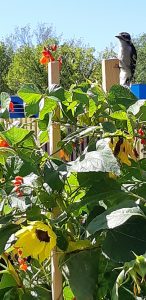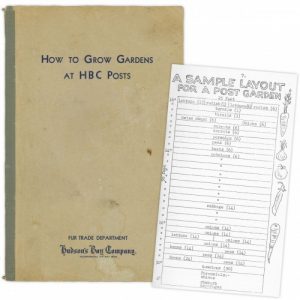HBC Gardens and Garden Seeds
Everyone is thinking about garden seeds, or could be. In 2021 I set out to grow vegetables that might have been grown in a Hudson Bay Company post garden at the 53rd/54th parallel and above. The growing season in Edmonton and area is short and intense, around 100 – 120 frost-free days (or less) between May 15 and September 15[i]
It might seem odd to write about Edmonton in a BC Food History blog. But once you are above the 53rd parallel, there are many similarities between Alberta and BC, in the interior and north. The Peace Country of Northern Alberta and BC know no boundary. The Rockies don’t stop at the BC/Alberta border. Both provinces have strong Indigenous / First Nations presences and were influenced by the Hudson Bay Company and the fur trade.
In the early days, Europeans were highly dependent on the food-getting abilities of the First Nations / Indigenous peoples[ii]. In 1670 the Hudson Bay Company was founded and various forts and outposts were established along the rivers and lakes north and west of Thunder Bay. Garden seeds were valued; Indigenous peoples would trade furs for dried pea seeds[iii], and starving traders sometimes even ate the garden seeds to survive. Scurvy, caused by vitamin deficiency, took many lives. Some form of vegetables was greatly needed.
In 1820 the NorWest Company and HBC merged under the money-focused leadership of Sir George Simpson. He wanted to make profit for the shareholders and pushed the voyageurs to work extremely long, bone-wracking days. They required 8,000 to 12,000 Calories per day, obtainable only from high-fat foods such as pemmican. There was no time to hunt and live off the land as the Indigenous peoples had done for thousands of years. For example, the prairie turnip was a valuable source of carbohydrates; but it took three years to mature and required knowledge held only by Indigenous peoples to harvest[iv] (1). As a result, the HBC promoted cold-tolerant vegetables with short growing seasons such as potatoes and cabbage. Some researchers have critically analyzed the introduction of European plants and defined it as horticultural imperialism, causing the decline of native plants by overtaking the natural plant systems[v].
A 1942 pamphlet is available on how to grow an HBC post garden. Among other points, it describes how to build a cold frame and lists the earliest planting dates for various hardy vegetables at northern posts.
The Grist Mill and Gardens at Keremos, BC provided me with a sample HBC garden plan focused on 1860 plant varieties, based on research by retired agronomist Sharon Rempel. In her online publication, she has provided lists of additional vegetable varieties suitable for a heritage garden. http://www.grassrootsolutions.com/
- Here is a short summary of the four main types of seeds and plants[vi].
- Open pollinated plants- are pollinated by nature (insect, bird, wind or animal).
- Heirloom seeds – have been grown for 50 years or longer. They will look like the parent plant so long as the flowers were pollinated by the same variety. This means they grow true to type. All heirlooms are open pollinated, but not all open-pollinated plants are heirlooms.
- Heritage seeds seem to be synonymous with heirloom.
- Hybrid seed comes from open pollination between two specific varieties of plants. They might be selected for specific desirable characteristics, but seed saved from them will not grow true to type.
My 2021 pocket garden project at the Edmonton Urban Farm focused on vegetables with a short growing season.. Most HBC posts were considered to be subarctic conditions, suitable for potatoes, peas, cabbage and parsnips. After about 1840 rhubarb was mandated by HBC for its natural laxative and purgative qualities, or in other words, to stop constipation caused by an all-meat diet. In 2020 I planted two types of rhubarb and they both came up in 2021. Borage and lovage also came up as volunteers from the year before.
I grew two varieties of heirloom potatoes (Amarosa and Columba), dwarf sugar snap peas, early Jersey Wakefield cabbage, and hollow crown parsnips. I could not find oxheart carrots so I tried some Nantes-type carrots. With the remaining garden space I included a three sisters and one cousin structure of corn, beans, squashes and sunflowers. I threw in some garlic, lovage, carrots and tomatoes, as well as eggplant for the sheer thrill of it. Nothing grew very well, except the cabbages, which provided a lot of food for cabbage butterflies, and the parsnips. Next year, who knows? (and you know what – It’s taken until 2025 to get back in the swing of gardening….)
My favourite quote about gardening is from a 1970 Beaver article by Dr. Douglas Leechman, a noted historian. He catalogued many of the issues surrounding the pursuit of food security and sufficiency, and quoted the HBC Committee in 1682, written in a response to a query from a man named John Nixon who asked about successes and failures of gardening: “Let the event be what it will let it be done[vii].”
Or in other words, every time a gardener plants something is an experiment. Plants vary according to growing conditions; the gardener can only do so much, and enjoy the doing as much as the product.
[i] Many sources offer information on hardiness zones in Canada. Here are two of many: The Farmers’ Almanac, or a seed company such as https://www.veseys.com/ca/canada-hardiness-zones-frost-dates
[ii] BC First Nations / Indigenous peoples met their food needs for thousands of years before newcomers and settlers. You can see a number of past BC history posts by searching the Heritage and Indigenous Foods search category on the home page.
[iii] Pierre-Esprit Radisson took dried pea seeds with him to trade with the Cree at the bottom of James Bay. Benjamin Frobisher ate his garden seeds when starvation loomed. See Mark Bourrie’s 2019 Bush Runner: The Adventures of Pierre-Esprit Radisson (p. 205) and George Colpitts (2014), Pemmican Empire (p. 42).
[iv] See Lisa Castle’s dissertation on The Prairie Turnip. Thanks to Dr. Nancy Turner for this reference.
Castle, L. M. (2006). The prairie turnip paradox: Contributions of population dynamics, ethnobotany, and community ecology to understanding pediomelum esculentum root harvest on the great plains. Unpublished dissertation. University of Kansas. If you would like to locate the article, put the title into your searchbar. An abstract is available through the University of Lethbridge.
[v] See Beverly Soloway’s article.
Soloway, B. (2015). “mus co shee”: Indigenous plant foods and horticultural imperialism in the Canadian sub-arctic. Canadian Bulletin of Medical History = Bulletin Canadien d’Histoire De La Medecine, 32(2), 253-273. https://doi.org/10.3138/cbmh.32.2.253
[vi] The Real Dirt Blog. Master Gardeners of Butte County, Montana. https://ucanr.edu/blogs/blogcore/postdetail.cfm?postnum=17076
[vii] Leechman, D. (1970). Fractious farming at the fur trade posts. The Beaver [now Canadian History Magazine]
https://www.canadashistory.ca/explore/environment/fractious-farming-at-the-fur-trade-posts
Note about Varieties:
Cabbages and parsnips thrived in my 2021 garden. Here is some information about the varieties.
Name: Early Jersey Wakefield cabbage (Brassica oleracea var. capitate)
History: Heirloom cabbage, first named as a variety of cabbage in 1840 by Francis Brill of New Jersey.
Days to Maturity: Spring/Summer 65 days, Fall/Winter 70-80 days
Hardiness: Cabbages are very hardy and can be frost tolerant.
USDA Hardiness Zone: 2-11
Produces: pointed heads that average 2-3 lbs.
Name: Hollow Crown Parsnips (Pastinaca sativa)
History: Heirloom parsnip, a popular variety in the 1820s. Brought to Britain by the Romans 2000 years ago. Staple vegetable in Europe before potatoes.
Days to Maturity: 100 – 120 days.
Hardiness: Harvest after frost for sweeter taste. Frost tolerant.
Produces: tasty, white, long roots, sweet flavor.





